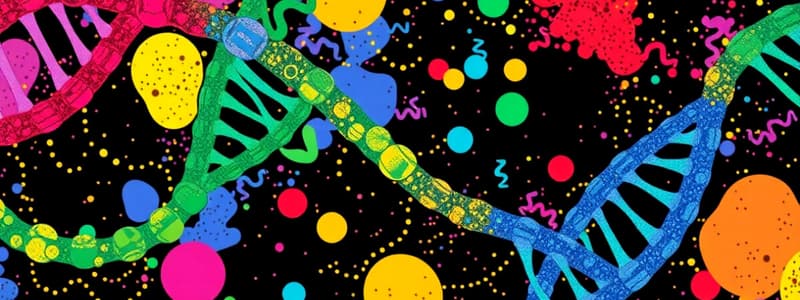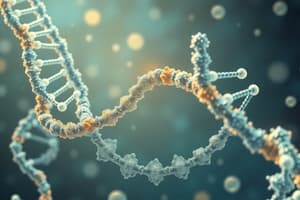Podcast
Questions and Answers
Which carbon atom of the sugar moiety within a nucleotide is the phosphate group typically attached to?
Which carbon atom of the sugar moiety within a nucleotide is the phosphate group typically attached to?
- C-2
- C-5 (correct)
- C-1
- C-3
Tautomerism in nitrogenous bases involves the interconversion between which forms?
Tautomerism in nitrogenous bases involves the interconversion between which forms?
- D and L isomers
- Alpha and beta anomers
- Keto/enol and amino/imino forms (correct)
- Syn and anti conformers
Under physiological conditions, which tautomeric forms of purines and pyrimidines are most prevalent?
Under physiological conditions, which tautomeric forms of purines and pyrimidines are most prevalent?
- Keto and amino forms together (correct)
- Lactim and imino forms together
- Keto and imino forms together
- Enol and imino forms together
What structural characteristic of the β-N-glycosidic bond in nucleotides restricts free rotation?
What structural characteristic of the β-N-glycosidic bond in nucleotides restricts free rotation?
Which conformer is predominantly found for nucleotides due to the restricted rotation around the glycosidic bond?
Which conformer is predominantly found for nucleotides due to the restricted rotation around the glycosidic bond?
Which of the following is the correct pairing of a base, its corresponding nucleoside, and its corresponding nucleotide?
Which of the following is the correct pairing of a base, its corresponding nucleoside, and its corresponding nucleotide?
Which of the following nitrogenous bases is exclusively found in DNA?
Which of the following nitrogenous bases is exclusively found in DNA?
Which of the following is NOT a function of purine nucleotides?
Which of the following is NOT a function of purine nucleotides?
What type of bond connects a nitrogenous base to a pentose sugar in a nucleoside?
What type of bond connects a nitrogenous base to a pentose sugar in a nucleoside?
S-adenosyl methionine (SAM) serves as a donor of what?
S-adenosyl methionine (SAM) serves as a donor of what?
In which of the following processes do pyrimidine nucleotides, specifically uridine diphosphate glucose (UDP-glucose), participate?
In which of the following processes do pyrimidine nucleotides, specifically uridine diphosphate glucose (UDP-glucose), participate?
A nucleotide is composed of which of the following components?
A nucleotide is composed of which of the following components?
Which of the following best describes the structural difference between purines and pyrimidines?
Which of the following best describes the structural difference between purines and pyrimidines?
Which of the following is a function of nucleotide derivatives in energy metabolism?
Which of the following is a function of nucleotide derivatives in energy metabolism?
Methylated xanthines, such as caffeine and theophylline, are commonly found in which of the following?
Methylated xanthines, such as caffeine and theophylline, are commonly found in which of the following?
Why are minor bases like 5-methyl cytosine and N7-methylguanine important?
Why are minor bases like 5-methyl cytosine and N7-methylguanine important?
Which carbon atom of the pentose sugar is involved in the formation of the N-glycosidic bond with a nitrogenous base?
Which carbon atom of the pentose sugar is involved in the formation of the N-glycosidic bond with a nitrogenous base?
A researcher identifies a modified nucleotide with an unusual base. After analysis, the base is determined to be methylated. This modified base is most likely:
A researcher identifies a modified nucleotide with an unusual base. After analysis, the base is determined to be methylated. This modified base is most likely:
If a cell were unable to produce uracil, which of the following processes would be most directly affected?
If a cell were unable to produce uracil, which of the following processes would be most directly affected?
Which of the following is an example of a purine base?
Which of the following is an example of a purine base?
Flashcards
Nucleotides
Nucleotides
Building units of nucleic acids, composed of a nitrogenous base, pentose sugar, and phosphate group.
DNA
DNA
Deoxyribonucleic acid, a type of nucleic acid.
RNA
RNA
Ribonucleic acid, a type of nucleic acid
Nitrogenous bases
Nitrogenous bases
Signup and view all the flashcards
Purines
Purines
Signup and view all the flashcards
Pyrimidines
Pyrimidines
Signup and view all the flashcards
Minor bases
Minor bases
Signup and view all the flashcards
Methylated xanthines
Methylated xanthines
Signup and view all the flashcards
Nucleosides
Nucleosides
Signup and view all the flashcards
β-N-glycosidic bond
β-N-glycosidic bond
Signup and view all the flashcards
What are nucleotides?
What are nucleotides?
Signup and view all the flashcards
C-5 of the sugar
C-5 of the sugar
Signup and view all the flashcards
What is tautomerism?
What is tautomerism?
Signup and view all the flashcards
Keto and amino forms
Keto and amino forms
Signup and view all the flashcards
Syn and anti-conformers
Syn and anti-conformers
Signup and view all the flashcards
Anti-conformer
Anti-conformer
Signup and view all the flashcards
What is ATP and GTP?
What is ATP and GTP?
Signup and view all the flashcards
What are cAMP and cGMP?
What are cAMP and cGMP?
Signup and view all the flashcards
NAD, NADP, FAD, FMN
NAD, NADP, FAD, FMN
Signup and view all the flashcards
UDP-glucose
UDP-glucose
Signup and view all the flashcards
Study Notes
- Purine and pyrimidine bases and their derivatives, nucleosides, and nucleotides are the building blocks of nucleic acids.
- Nucleic acids have 2 main classifications: deoxyribonucleic acid (DNA) and Ribonucleic acid (RNA).
- Nucleotides are the building blocks of nucleic acids.
- Nucleotides are composed of a nitrogenous base, a pentose sugar, and a phosphate group.
Nitrogenous Bases
- Nitrogenous bases are heterocyclic ring compounds that contain carbon and nitrogen.
- Nitrogenous bases are classified based on their abundance within cells.
Major Bases
- Major bases are present in large amounts inside cells.
- Purines: adenine and guanine, are present in both DNA and RNA.
- Pyrimidines: cytosine is present in both DNA and RNA, thymine is present in DNA only, and uracil is present in RNA only.
Minor Bases
- Minor bases are present in trace amounts and are always methylated, for example, 5-methyl cytosine and N7-methylguanine.
- Minor bases are involved in oligonucleotide recognition, regulating the half-life of RNAs and protecting host DNA from digestion by DNAses.
- Bases such as xanthine, hypoxanthine, and uric acid are present in a free state, while methylated xanthine appears as caffeine in coffee and theophylline in tea.
- Theobromine appears in coca.
Nucleosides
- Nucleosides consist of a base and a sugar (ribose or deoxyribose).
- Sugars bind bases via a covalent, β-N-glycosidic bond that links C₁ of sugar with N-9 of a purine, or N-1 of a pyrimidine.
- The numbering of the sugar atoms uses a prime symbol to distinguish sugar atoms from those of the base.
Nucleotides
- Nucleotides consist of a base, a sugar, and a phosphate group.
- Phosphate is attached to the C-5 position of the sugar.
Tautomerism
- Purines and pyrimidines exist in two isoforms: keto (or lactam) or enol (lactim) form, and amino (-NH2) or imino (=NH) form.
- Tautomerism is the change from one isoform to the other.
- Keto and amino forms are common at physiological pH.
Syn and Anti-Conformers
- Nucleotides exist in stable non-interconvertible syn and anti conforms.
- The β-N-glycosidic bond is a very firm bond with restricted rotation.
- Interconversion between conformers requires rupture and reformation of the glycosidic bond.
- The anti-conformer predominates.
Nucleotide Functions
- Both purine and pyrimidine nucleotides are structural components of nucleic acids (DNA and RNA).
- Purine nucleotides are key components of high-energy storage molecules like ATP and GTP.
- Intracellular signaling molecules such as cAMP and cGMP, act as secondary messengers for many hormones.
- Purines enter the structure of hydrogen carrier coenzymes, such as NAD, NADP, FAD, and FMN.
- Purines serve as acid carrier coenzymes, such as CoASH.
- Purines are part of the active methyl donor S-adenosyl methionine (SAM).
- Purines are part of the active sulfate donor 3'-phosphoadenosine-5'-phosphosulfate (PAPS).
- ADP levels regulate the rate of oxidative phosphorylation in mitochondria.
- Pyrimidine nucleotides are components of high-energy intermediates e.g. uridine diphosphate glucose (UDP-glucose) used in glycogenesis and the uronic acid pathway.
- Pyrimidines are components of high energy stores like CTP and UTP.
Studying That Suits You
Use AI to generate personalized quizzes and flashcards to suit your learning preferences.



